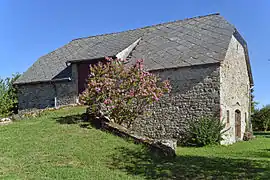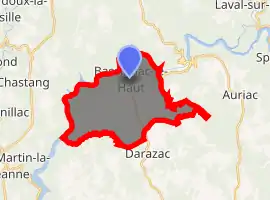Bassignac-le-Haut
Bassignac-le-Haut is a commune in the Corrèze department in the Nouvelle-Aquitaine region of central France.[2]
Bassignac-le-Haut | |
|---|---|
 An old barn in Bassignac-le-Haut | |
.svg.png.webp) Coat of arms | |
Location of Bassignac-le-Haut 
| |
 Bassignac-le-Haut  Bassignac-le-Haut | |
| Coordinates: 45°12′44″N 2°04′21″E | |
| Country | France |
| Region | Nouvelle-Aquitaine |
| Department | Corrèze |
| Arrondissement | Tulle |
| Canton | Argentat-sur-Dordogne |
| Intercommunality | Community of communes of Canton de Saint-Privat |
| Government | |
| • Mayor (2014–2020) | Jean Claude Turquet |
| Area 1 | 18.37 km2 (7.09 sq mi) |
| Population (2017-01-01)[1] | 179 |
| • Density | 9.7/km2 (25/sq mi) |
| Time zone | UTC+01:00 (CET) |
| • Summer (DST) | UTC+02:00 (CEST) |
| INSEE/Postal code | 19018 /19220 |
| Elevation | 253–628 m (830–2,060 ft) (avg. 540 m or 1,770 ft) |
| 1 French Land Register data, which excludes lakes, ponds, glaciers > 1 km2 (0.386 sq mi or 247 acres) and river estuaries. | |
The inhabitants of the commune are known as Bassignacois or Bassignacoises .[3]
Geography
Bassignac-le-Haut is located in the Massif Central some 20 km north-east of Argentat and 20 km south-east of Tulle. Access to the commune is by the D13 road from Darazac in the south which passes through the commune and the village before continuing north-east along the banks of the river then across to Saint-Merd-de-Lapleau. Apart from the village there are the hamlets of Le Bousquet, Vaujour, Le Mas, Vernac, Maurel, and Ymons in the commune. The commune is mostly farmland but heavily forested along the river.[4][5]
A lake formed by the Barrage du Chastang dam on the Dordogne river forms all the western and northern border of the commune. The Ruisseau de vaujour rises in the north-west of the commune and flows the short distance north-west to the Dordogne. Similarly the Ruisseau du Roc Chabrier rises in the north and flows north into the Dordogne. The Ruisseau de la Cascade flows north through the eastern part of the commune to join the Dordogne east of the commune. The Ruisseau de Vieilzot rises just south of the commune and forms much of the southern border as it floes west to join the Dordogne in the south-western tip of the commune.[4][5]
History
Bassignac-le-Haut appears as Baßignac le Haut on the 1750 Cassini Map[6] and as Bassignac le Haut on the 1790 version.[7]
Heraldry
.svg.png.webp) Arms of Bassignac-le-Haut |
The official status of the blazon remains to be determined.
Blazon: |
Administration
| From | To | Name | Party | Position |
|---|---|---|---|---|
| 2001 | 2007 | Raymond Delmas | ||
| 2007 | 2008 | Hubert Lavesque | ||
| 2008 | 2011 | Josette Puyraymond | ||
| 2012 | 2020 | Jean Claude Turquet[9] |
(Not all data is known)
Demography
In 2017 the commune had 179 inhabitants.
|
| ||||||||||||||||||||||||||||||||||||||||||||||||||||||||||||||||||||||||||||||||||||||||||||||||||||||||||||||||||
| Source: EHESS[10] and INSEE[11] | |||||||||||||||||||||||||||||||||||||||||||||||||||||||||||||||||||||||||||||||||||||||||||||||||||||||||||||||||||
Culture and heritage


Religious heritage
The commune has several religious buildings and sites that are registered as historical monuments:
Notable people linked to the commune
- Stephen of Obazine (1085-1154), priest and hermit famed for his pious nature, born in the commune.
See also
References
- "Populations légales 2017". INSEE. Retrieved 6 January 2020.
- Bassignac-le-Haut on Lion1906
- Inhabitants of Corrèze (in French)
- Bassignac-le-Haut on Google Maps
- Bassignac-le-Haut on the Géoportail from National Geographic Institute (IGN) website (in French)
- Baßignac le Haut on the 1750 Cassini Map
- Bassignac le Haut on the 1790 Cassini Map
- List of Mayors of France (in French)
- General Council website - Bassignac-le-Haut (in French)
- Données Cassini, EHESS
- Population en historique depuis 1968, INSEE
- Ministry of Culture, Mérimée PA00099663 Ouradour Cemetery Cross (in French)
- Ministry of Culture, Mérimée PA00099665 Ciriex Cemetery Cross (in French)
- Ministry of Culture, Mérimée PA00099664 Covered Cross (in French)
- Ministry of Culture, Mérimée PA00099666 Church of Saint-Pierre-ès-Liens (in French)
- Ministry of Culture, Palissy PM19000851 Painting with frame: Saint Roch
 (in French)
(in French) - Ministry of Culture, Palissy PM19000850 Painting with frame: John the Baptist
 (in French)
(in French) - Ministry of Culture, Palissy PM19000849 Altar Painting with frame: Christ on the Cross
 (in French)
(in French) - Ministry of Culture, Palissy PM19000848 Painting with frame: Presentation of the Rosary to Saints Dominic and Catherine
 (in French)
(in French)
External links
- Bassignac-le-Haut Official website (in French)
| Wikimedia Commons has media related to Bassignac-le-Haut. |